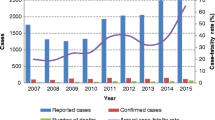Abstract
In this work the incidence of Mediterranean spotted fever in the Borough of Cagliari (Sardinia) over the years 1982–1984 is evaluated. Our data show both an overall decrease of the incidence of the disease during this period of time with respect to the year 1980 and a significant reduction in the last year.
In addition, the present study confirms the greater reliability of Immunofluorescence respect to the Weil-Felix reaction in revealing Mediterranean spotted fever. Finally we show a marked incidence of significant anti-Rickettsia conori antibodies in apparently healthy individuals, which stresses the not uncommon occurrence of subclinical infection.
Similar content being viewed by others
References
BuchmanR.E. and GibbonsM.E. (1975): Bergey's manual of determinative bacteriology. The William and Wilkins Company. Baltimore.
CiogliaL. (1979): Nozioni di Igiene. Ed. Monduzzi, Bologna.
EdlingerE. (1978–79): Le diagnostic rapide des virus. La Fievre boutonneuse mediterranéenne. - Archives de l'Institut Pasteur Hellenique. Tomes XXIX-X XV 63–65.
EdlingerE. (1979): Serological diagnosis of Mediterranean spotted fever. - Ann. Microbiol. (Inst. Pasteur) 130A, 203–211.
EdlingerE. (1980): Trois cas autochtones de typhus murin en France. Bulletin de la Societé de Pathologie exotique. Tome 73, n° 1, 4053.
EisemannC.S. and Osterman J.F. (1976): Proteins of typhus and spotted fever Rickettsiae. - Infect. Immun. 14, 155–162.
HananH. and CookeK.O. (1966): Assay of Coxiella Burneti by enumeration of immunofluorescent infected cells. - J. Immunol. 97, 492–497.
IppolitoA., RagoM. e GigantinoL. (1983): La febbre bottonosa. Contributo clinico. - Giorn. Mal. Infettive e Parassitarie, 35, 490–494.
LefebvreJ.C., FavierG., Della MonicaP. and VandekerkoveM. (1979): Diagnostic de la fievre boutonneuse mediterranéenne par immunofluorescence indirect. - La Nouvelle Press Medicale, 8, 1431.
LennetteE.H., BalowsA., HauslerW.J. and TruantJ.P. (1980): Manual of Clinical Microbiology 3rd ed. American Society for Microbiology. Washington D.C.
MandellG.L., DouglasR.G. and BernettJ.E. (1979): Principles and pratice of infectious disease. Wiley Med. Pubbl. John Wiley and Sons N.Y.
OteroR., FemollA. and CasalJ. (1982): Resurgence of mediterranean spotted fever. - The Lancet, Nov. 13, 1107.
PedersenC.E., BagleyL.R., KenyonR.H., SammonsL.S. and BurgerG.T. (1975): Demonstration of Rickettsia rickettsii in the resus monkey by immunefluorescent microscopy. - J. Clin. Microbiol. 2, 121–125.
PompeiR., PintusL.e CareddaM. (1981): Analisi comparativa della affidabilità della reazione di Weil-Felix e del test di immunofluorescenza per la Rickettsia conovi. - Giorn. Ig. Med. Prev. 18, 1–9.
TraubR., WissermanC.L. and FarhamgA.R. (1978): The ecology of murine typhus: a critical review. -Trop. Dis. Bull. 73, 237–317.
Author information
Authors and Affiliations
Additional information
Corresponding author.
Rights and permissions
About this article
Cite this article
Pompei, R., Caredda, E., Pasqui, E. et al. Incidence of Mediterranean spotted fever in Sardinia in the years 1982–1984. Eur J Epidemiol 1, 117–120 (1985). https://doi.org/10.1007/BF00141803
Issue Date:
DOI: https://doi.org/10.1007/BF00141803



